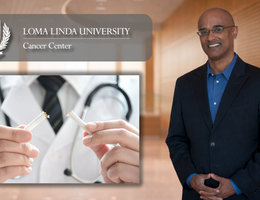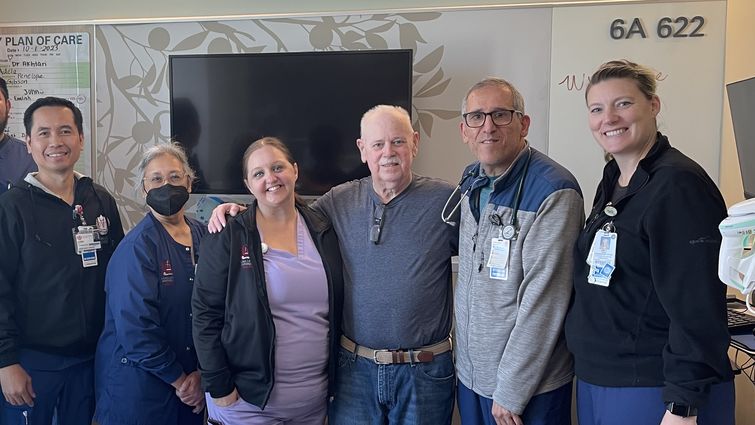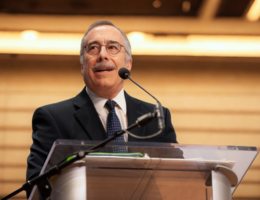

John Gilmore says he was glad to partner with Loma Linda University Cancer Center's care team to undergo an autologous stem cell transplant close to home.
Loma Linda University Cancer Center’s Bone Marrow Transplant program partners with the Veterans Affairs health system in the Inland Empire to offer veterans stem cell transplants tailored to their needs close to home. Stem cell transplants keep certain blood cancers in remission and prolong patients’ lives for years to come.
Within a year of diagnosis, 68-year-old army veteran John Gilmore pushed his mantel cell lymphoma into complete remission, meaning all signs and symptoms of the blood cancer disappeared. Next, he partnered with the Cancer Center, where he underwent an autologous stem cell transplant — using healthy blood stem cells from his own body to replace diseased blood.
Evidence has proven the transplant method helps patients with cancers such as mantle cell lymphoma, improving progression-free survival by adding years to their life expectancy in remission, says Mojtaba Akhtari, MD, a hematologist-oncologist, professor of medicine, and chief of adult bone marrow stem cell transplant at the Cancer Center.
We use our expertise and teamwork to constantly adjust patients' treatment plans.Dr. Mojtaba Akhtari
Akhtari says each patient at the Cancer Center receives personalized care, meaning care teams tailor treatment plans to individuals’ unique health circumstances and preferences. In Gilmore's case, kidney dysfunction initially disqualified him from undergoing a stem cell transplant. Akhtari assessed Gilmore’s situation at the Transplant and Cellular Therapy Committee meeting, a multidisciplinary group of cancer experts who dedicate time to discuss individualized patient treatment plans to optimize their outcomes.
After speaking with Akhtari and conducting his own research, Gilmore agreed to modify his treatment regimen — based on scientific evidence — to enable him to receive the transplant.
“The care team didn't just use one size fits all, textbook therapy, but instead crafted the treatment plan for my body and my specific needs,” Gilmore says. “They were nimble in adjusting to my particular circumstances in real-time, and this was truly an evolving plan based on my needs.”
Each patient presents with different circumstances or comorbidities, Akhtari says; personalized care honors that reality, ensuring each patient has the best chance of healing. He says the stem cell transplant process requires a “village” of care team members to successfully coordinate the patient’s care: nurses, social workers, pharmacists, program coordinators, nutritionists, physicians, and staff at labs, apheresis, and the blood bank.
“Loma Linda University Health sees humans as a whole, and our duty is to take care of all the moving parts that make up the whole,” Akhtari says. “We use our expertise and teamwork to constantly adjust patients' treatment plans.”
Read: Veteran uses his own stem cells in transplant to stave off blood cancer, prolong life
Patients must stay close to transplant centers for at least three months post-transplant, Akhtari says. Some patients from the region have previously needed to seek stem cell transplants outside of the state, undergoing a life-changing procedure far from a familiar environment and loved ones. The Cancer Center’s Bone Marrow Transplant program thus offers a valuable, accessible service for people living in the region as one of the only programs to offer autologous stem cell transplants in the Inland Empire.
As a veteran living in Victorville, Gilmore says he was glad to be able to access this transplant close to home. He underwent the transplant in September.
“Ultimately, the Cancer Center was the right choice for me,” he says. “I've never had so many people involved in my well-being. I'm humbled by the care and kindness shown to me by so many. Everything was so well choreographed by the cancer team. Clearly, they've done this before and knew what they were doing.”
As Gilmore continues his recovery, he looks forward to reuniting with his group of veteran friends for routine motorcycle trips to the mountains and along the coast. As a computer information technology security professional, Gilmore says he takes advantage of spending time outdoors, hiking or kayaking, when he is not working.
Akhtari says he and his team are honored to provide stem cell transplants to veterans like Gilmore, one of approximately 215,000 veterans living in the Inland Empire, according to U.S. VETS Inland Empire.
“I'm grateful that Mr. Gilmore trusted us and allowed us to care for him,” Akhtari says. “I always say that it's an honor and privilege to take care of patients with cancer.”
Loma Linda University Cancer Center offers patients comprehensive care that gives them the best opportunity to face cancer. To learn more about all of the resources offered to cancer patients at the center, visit lluh.org/cancer-center or call 1-800-782-2623 to make an appointment.

